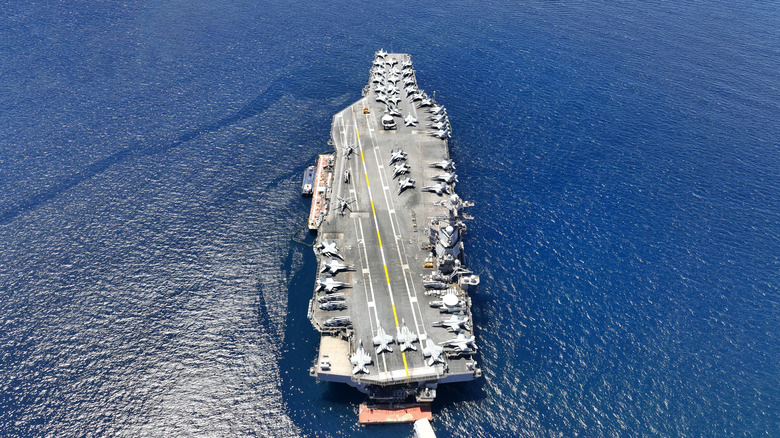Which American Aircraft Carriers Have Electromagnetic Catapults?
The United States Navy currently has 11 nuclear-powered aircraft carriers in its fleet. Of those, 10 are of the "old" Nimitz-class, while a singular example of the latest high-tech model is the Gerald R. Ford (CVN-78), which also happens to be the name of this new class of carrier. Both the Nimitz and Gerald R. Ford-class carriers are considered the largest warships on the planet.
The Ford was delivered in 2017 as the replacement for the USS Enterprise (CVN-65), which was made inactive in 2012 and decommissioned in 2017. Given that the Ford is the latest carrier to sail the high seas, it should come as no surprise that it's packing the latest and greatest technology, including an Electromagnetic Aircraft Launch System (EMALS). It is the only carrier currently equipped with EMALS, but every one of the additional ten Ford-class carriers to come (each with a price tag of $13 billion) will also include EMALS.
For the last several decades, the Navy has used steam-powered catapults to launch its aircraft. EMALS, however, uses stored kinetic energy and converted solid-state electricity to power a linear induction motor. It's an exponential leap in technology that allows more precise computer control, monitoring, and automation. EMALS provides 29% more energy than the steam system, which in turn allows it to launch heavier aircraft if needed. Additionally, it offers a greater linear acceleration curve for lighter aircraft, reducing wear and tear on the plane.
EMALS is ready to launch a bevy of aircraft
The traditional catapult, which utilized steam diverted from the ship's nuclear reactor, have been reliable for decades. However, they were too powerful and, over time, reduced the lifespan of the extremely expensive airframes. Imagine a blast of hard-to-control steam dragging a fighter plane down a groove along the flight deck and flinging it into the air. In fact, it was so overpowered that many lighter aircraft couldn't be launched.
EMALS is purpose-designed and built to reduce maintenance requirements, resulting in lower costs over time. It takes power directly from the ship's generator and powers electromagnets that, in turn, accelerate an aircraft down the flight deck, much like a slug shot from a railgun. This technology offers a range of benefits over the tried and true system. First and foremost, it will require fewer personnel to operate and is both quieter and cooler. EMALS offers increased reliability and efficiency, as well as a smoother acceleration.
Now, the Navy will be able to launch a whole new assortment of aircraft from its carriers, simultaneously expanding its operational capability and increasing sortie generation rates (SGR). In July 2025, the USS Gerald R. Ford completed its first shipboard launch of a fleet fixed-wing aircraft using EMALS, in this case, an F/A-18F Super Hornet. It also successfully recovered the fighter jet using the Advanced Arresting Gear (AAG) system for the first time. It's a significant win for the Navy, as the system failed during a previous test in front of assembled media.
